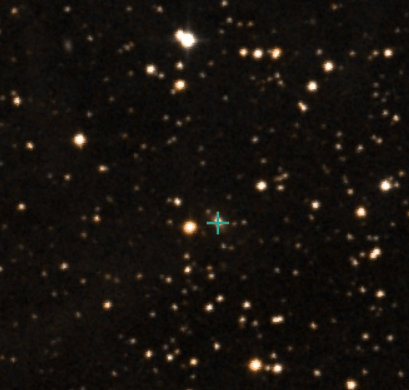Star of the Month
BL Lacertae
AKA: OY+401, VR 42.22.01
Position: 22 hrs 02 min 43.3 sec +42 degrees 16 min 40 sec
Due south at 21.25 (BST) on 15 October 2021
BL Lacertae (shown with a cross)
Image: Simbad (http://simbad.u-strasbg.fr/simbad/)
By calling BL Lacertae a star of the month, I am cheating a bit because it is no longer considered to be a star. With a magnitude of around 15, it is also a very challenging object to observe and you will either need to have a very large telescope, or else use imaging. However, I have included it as it is interesting. In 1929, the energetic variable star observer Cuno Hoffmeister from Sonneberg in Thuringia in Central Germany (best known for its toy industry) reported 354 [sic] new variables, one of which was BL Lacertae which he had first observed in 1926. This was a rather variable “star” which changes from magnitude 13 to 16 in roughly 200 days, but can sometimes flare up to around magnitude 12. BL Lacertae was considered to be the prototype of a group of variable stars called Lacertids. Then almost forty years after Hoffmeister’s paper was published, a strong radio signal was detected by John Schmitt at the David Dunlap Observatory in Toronto from the same area, and it was realised that BL Lacertae was not a star at all but was in fact a quasar, like the recently discovered 3C 273 (see the DSO of the Month for May 2021).
When even more quasars had been discovered, it was realised that BL Lacertae was the prototype of a group of quasars (or more precisely active galactic nuclei or AGNs) which were very variable and had a featureless spectrum, in contrast to most AGNs. These objects were also often more visible in the optical region than in the radio region. Subsequently the BL Lac objects were included in a broader class of AGNs called blazars which had a characteristic radio spectrum. The name blazar was coined by the astronomer Edward Spiegel of Columbia University at a conference on BL Lac objects in Pittsburgh in 1978. The term was coined from BL Lac and quasar but with a nod towards the verb ‘blaze’, to indicate their energetic nature. Then unfortunately a weak line was discovered in the spectrum of BL Lacertae, which should have led to its summary expulsion from the class of BL Lac objects and hence blazars. However it seemed silly (or at least sad) to remove the prototype from the group of AGNs it had so kindly lent its name to, so the definition was broadened to AGNs with an almost featureless spectrum. If I tell you that BL Lacertae is no less than 900 million light years away or over 350 times more distant than the Andromeda Galaxy (and hence speeding away from us at 21,000 km/s) and yet with an admittedly large telescope we can actually see it, you will realise that (like 3C 273 which is also a blazar), it must be phenomenally energetic. You might also surmise that this energy can only come from a supermassive black hole with jets moving at close to the speed of light. In fact blazars are defined as AGNs with relativistic jets pointing towards us. So BL Lacertae is yet another case where (equipment permitting) you can “see” a black hole from your garden.
Unfortunately it is not easy to tell you how to locate BL Lacertae as there are no bright stars (or even moderately dim stars) close to it. It lies between the small constellation of Lacerta (specifically to the west of 1 and 6 Lacertae) and the rear of Cygnus (specifically to the east of Epsilon Cygni (Gienah) and Deneb). You will have to use a star map and go-to find it.
